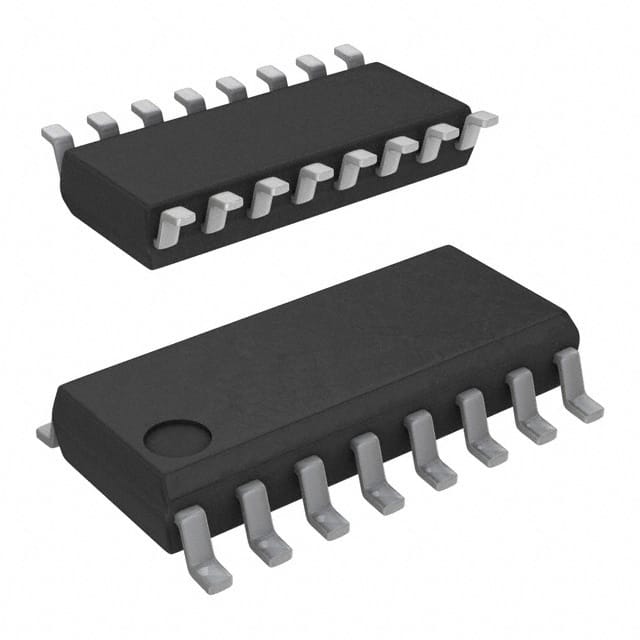Consulte las especificaciones para obtener detalles del producto.

SN74F109DRG4
Product Overview
- Category: Integrated Circuit (IC)
- Use: Flip-Flop
- Characteristics: Dual Positive-Edge-Triggered D-Type Flip-Flop with Set and Reset
- Package: SOIC (Small Outline Integrated Circuit)
- Essence: The SN74F109DRG4 is a dual flip-flop IC that can store and manipulate binary data. It is designed to be triggered by positive edges of clock signals, allowing for synchronized data storage and retrieval.
- Packaging/Quantity: The SN74F109DRG4 is typically sold in reels or tubes, containing a specific quantity of ICs per package.
Specifications
- Supply Voltage Range: 4.5V to 5.5V
- High-Level Input Voltage: 2V
- Low-Level Input Voltage: 0.8V
- High-Level Output Voltage: 2.7V
- Low-Level Output Voltage: 0.5V
- Maximum Clock Frequency: 100MHz
- Operating Temperature Range: -40°C to 85°C
Detailed Pin Configuration
The SN74F109DRG4 has a total of 16 pins, each serving a specific function:
- CLR (Clear) - Active-Low Clear Input
- D1 (Data Input 1) - Data Input for Flip-Flop 1
- CLK (Clock) - Clock Input
- D2 (Data Input 2) - Data Input for Flip-Flop 2
- PR (Preset) - Active-Low Preset Input
- Q1 (Flip-Flop 1 Output) - Output for Flip-Flop 1
- Q1̅ (Flip-Flop 1 Complementary Output) - Complementary Output for Flip-Flop 1
- GND (Ground) - Ground Connection
- Q2 (Flip-Flop 2 Output) - Output for Flip-Flop 2
- Q2̅ (Flip-Flop 2 Complementary Output) - Complementary Output for Flip-Flop 2
- VCC (Supply Voltage) - Positive Supply Voltage
- S1 (Set) - Active-Low Set Input for Flip-Flop 1
- R1 (Reset) - Active-Low Reset Input for Flip-Flop 1
- S2 (Set) - Active-Low Set Input for Flip-Flop 2
- R2 (Reset) - Active-Low Reset Input for Flip-Flop 2
- NC (No Connection) - Unused Pin
Functional Features
- Dual Flip-Flop: The SN74F109DRG4 consists of two independent flip-flops, allowing for the storage and manipulation of two separate binary values.
- Positive-Edge Triggered: The flip-flops are triggered by positive edges of the clock signal, ensuring synchronized data storage and retrieval.
- Set and Reset Inputs: The flip-flops have set and reset inputs, enabling the initialization or modification of stored data.
- Complementary Outputs: Each flip-flop has a complementary output, providing both the normal and inverted versions of the stored data.
Advantages and Disadvantages
Advantages: - Dual flip-flop design allows for simultaneous storage and manipulation of two binary values. - Positive-edge triggering ensures synchronized operation with other components in a digital system. - Set and reset inputs provide flexibility in initializing or modifying stored data. - Complementary outputs facilitate compatibility with various logic circuits.
Disadvantages: - Limited to positive-edge triggering, which may not be suitable for all applications requiring flip-flop functionality. - Requires external components for proper power supply and clock signal generation. - May not be the most power-efficient option compared to other flip-flop ICs.
Working Principles
The SN74F109DRG4 operates based on the principles of sequential logic. When a positive edge is detected on the clock input, the data present at the D1 and D2 inputs are latched into the respective flip-flops. The stored data can be modified using the set and reset inputs, allowing for dynamic manipulation. The complementary outputs provide both the normal and inverted versions of the stored data, enabling compatibility with various logic circuits.
Detailed Application Field Plans
The SN74F109DRG4 can be used in various digital systems where the storage and manipulation of binary data is required. Some potential application fields include:
- Digital Counters: The dual flip-flop design makes it suitable for implementing counters that require multiple stages.
- State Machines: The set and reset inputs enable the creation of complex state machines with different states and transitions.
- Data Synchronization: The positive-edge triggering ensures synchronized data storage and retrieval in communication systems.
- Address Decoding: The flip-flops can be used in address decoding circuits to select specific memory
Enumere 10 preguntas y respuestas comunes relacionadas con la aplicación de SN74F109DRG4 en soluciones técnicas
Sure! Here are 10 common questions and answers related to the application of SN74F109DRG4 in technical solutions:
Q: What is SN74F109DRG4? A: SN74F109DRG4 is a dual J-K flip-flop integrated circuit (IC) that can be used in various digital logic applications.
Q: What is the operating voltage range for SN74F109DRG4? A: The operating voltage range for SN74F109DRG4 is typically between 4.5V and 5.5V.
Q: What is the maximum clock frequency supported by SN74F109DRG4? A: SN74F109DRG4 can support clock frequencies up to 100 MHz.
Q: Can SN74F109DRG4 be used as a counter? A: Yes, SN74F109DRG4 can be used as a binary counter when connected in a suitable configuration.
Q: How many flip-flops are there in SN74F109DRG4? A: SN74F109DRG4 contains two independent J-K flip-flops.
Q: What is the power consumption of SN74F109DRG4? A: The power consumption of SN74F109DRG4 is typically low, making it suitable for battery-powered applications.
Q: Can SN74F109DRG4 operate at high temperatures? A: Yes, SN74F109DRG4 has a wide temperature range and can operate reliably at high temperatures.
Q: What is the output drive capability of SN74F109DRG4? A: SN74F109DRG4 has a standard output drive capability, which is typically sufficient for most applications.
Q: Can SN74F109DRG4 be used in both synchronous and asynchronous applications? A: Yes, SN74F109DRG4 can be used in both synchronous and asynchronous applications, depending on the circuit configuration.
Q: Is SN74F109DRG4 available in different package options? A: Yes, SN74F109DRG4 is available in various package options, such as SOIC, PDIP, and TSSOP, to suit different PCB layouts and assembly requirements.
Please note that these answers are general and may vary based on specific datasheet specifications and application requirements.

